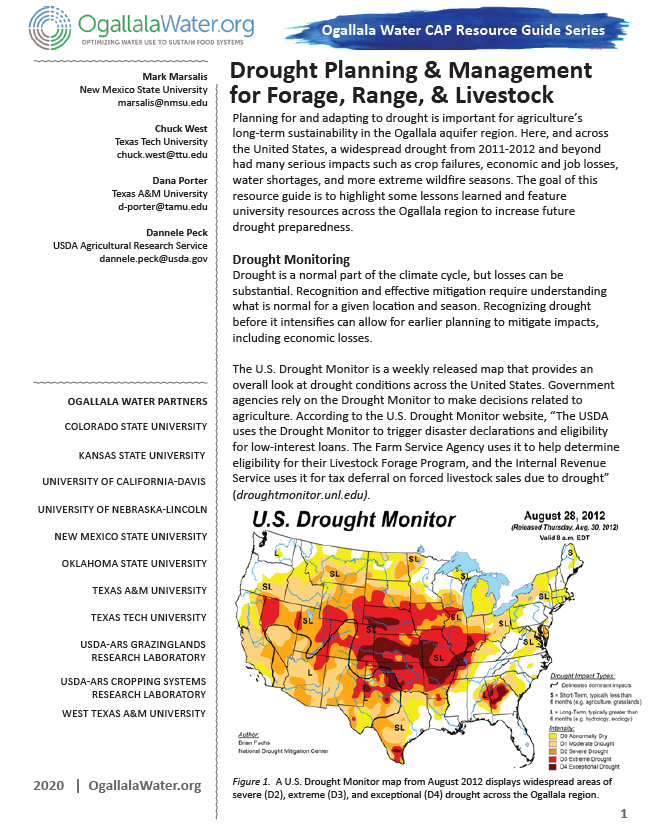Planning for and adapting to drought is important for agriculture’s long-term sustainability in the Ogallala aquifer region.
Here, and across the United States, a widespread drought from 2011-2012 and beyond had many serious impacts such as crop failures, economic and job losses, water shortages, and more extreme wildfire seasons.
The goal of this resource guide is to highlight some lessons learned and to feature other resources available from across the Ogallala region in order to encourage future drought preparedness.
A 2018 survey of over 1,100 Ogallala region producers found that 73% agree that aquifer groundwater should be conserved to prepare for future droughts (Lauer & Sanderson, 2019).
Drought Monitoring
Drought is a normal part of the climate cycle, but leads to substantial agricultural losses. Recognition and effective mitigation of drought require understanding what is normal for a given location and season. Recognizing drought before it intensifies can enable earlier planning to mitigate impacts, including economic losses.
The U.S. Drought Monitor map, released weekly, provides an overall look at drought conditions across the United States. Government agencies rely on the Drought Monitor to make decisions related to agriculture. According to the U.S. Drought Monitor website, “The USDA uses the Drought Monitor to trigger disaster declarations and eligibility for low-interest loans. The Farm Service Agency uses it to help determine eligibility for their Livestock Forage Program, and the Internal Revenue Service uses it for tax deferral on forced livestock sales due to drought” (droughtmonitor.unl.edu).
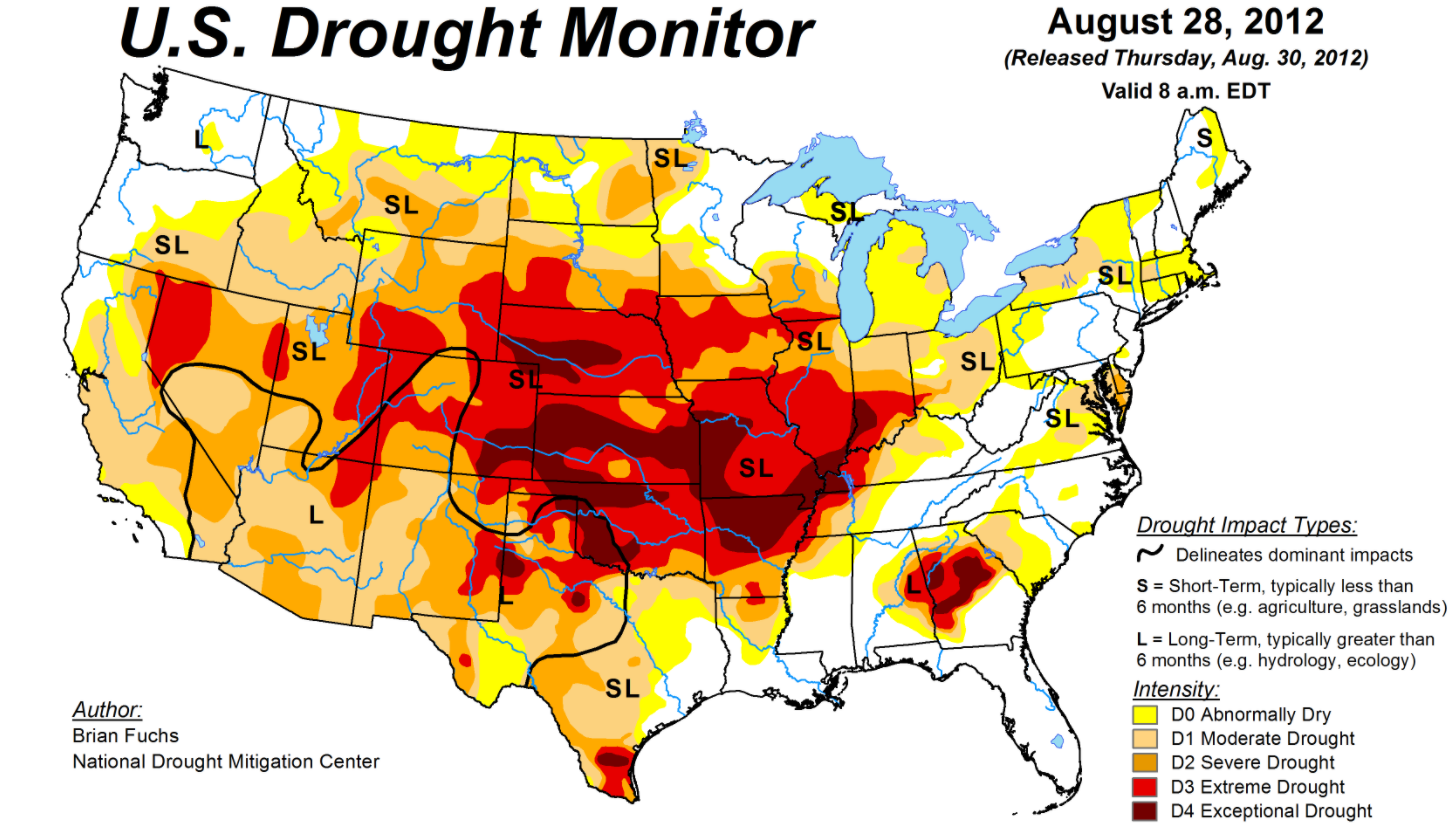
Figure 1. A U.S. Drought Monitor map from August 2012 displays widespread areas of severe (D2), extreme (D3), and exceptional (D4) drought across the Ogallala reigon.
Drought Impacts
“Even one-year droughts have multi-year impacts. It is common for the effects of drought in one year to result in lower conception rates and fewer calves born the next year. It can take years for pasture and range grasses to recover from drought, resulting in continued reduced stocking rates for several years. The financial impacts of a drought can also persist for years on a ranch’s cash flow and balance sheet. Economic analyses of droughts also require assessment of downstream impacts” (Anderson, Welch, & Robinson, 2012, p. 3).
2011-2013 Drought Impact to Ogallala Aquifer Levels
Historical water table levels of the Ogallala aquifer fluctuate by region and by rainfall amounts. Periods of faster declines are exacerbated by drought conditions and high crop prices, both of which induce greater pumping.
Over the entire Ogallala region, (Table 1) the average water level declined by an average of 2.1 feet from 2011 to 2013. By comparison, the overall “area-weighted” average water level from irrigation predevelopment (around 1950) to 2013 declined by 15.4 feet (McGuire, 2014).
Table 1. Water Level Changes in the High Plains (Ogallala) Aquifer by State (McGuire, 2014).
Drought Planning and Cattle Production Phases
The cattle industry in the Great Plains is highly productive thanks to irrigated feed crops and extensive grasslands, but the industry is very vulnerable to drought. The beef industry is sectored into three major phases, which affect the nature of impacts and plans for their management. Cow-calf ranches consist of beef cow herds which produce calves destined primarily for fattening in concentrated feeding operations (feedyards). These herds mostly graze nonirrigated (dryland or rainfed), semiarid to arid rangelands. Such grasslands are frequently in water deficit, so cattle are stocked very lightly. Ranchers usually provide supplemental feeds during winter and severe droughts. Adjusting stocking rate, herd size, and feed supplementation are among the few tools available to deal with shortages in rainfall.
Many calves weaned from cow herds enter the stocker phase, consisting of grazing improved forage crops or winter wheat on good soils for several months. Some stocker operations have the additional tool of irrigation to mitigate drought situations.
Finally, beef cattle enter feedyards, where they are fed high-grain diets with concentrated energy and protein. The primary forage mixed with concentrate feeds is corn silage, which is grown locally with irrigation. The impact of drought is the inability to pump enough groundwater to make up the deficit in rain, causing declines in silage yield and energy content. Importing silage from distant parts of the country generally is not feasible because of high water content, spoilage, and shipping costs. Grain is commonly shipped in from surplus regions, but widespread drought will cause high feed grain prices and lower profits.
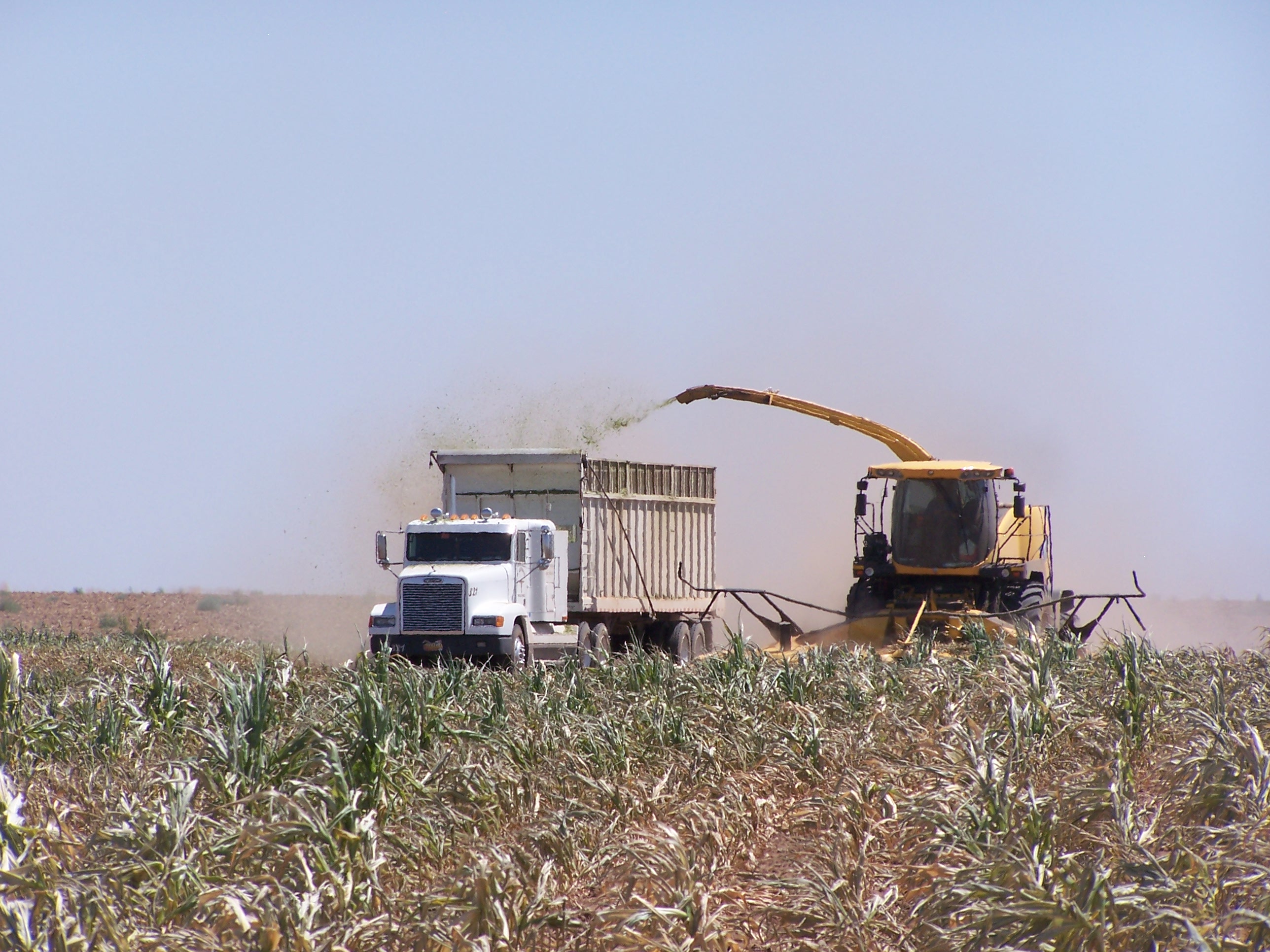
2011 drought-stressed corn silage harvest. Photo: Mark Marsalis
- Get help writing a drought plan.
- View sample drought plans from ranches throughout the Great Plains.
All beef production phases require that drought planning include determining drought impact on feed supply and quality, developing goals and contingency plans involving a management team, and setting critical dates and financial points that trigger those plans. The phases differ in planning details.
Cow-calf production is heavily land-focused. Mitigation strategies should include determining which soils and landscape positions dry out first, which dry out next, and which are last, and then describing this sequence by mapping the ranch accordingly, along with soil capability, condition of vegetation, and stock water sources. Areas of differing drought susceptibility should be fenced separately so that timing and intensity of grazing can be controlled. Ranch mapping enables one to set dates of forage availability and proper stocking rates to maintain range resiliency. Managers are tempted to purchase expensive hay and grain to maintain the herd, but reducing cow numbers and weaning calves early is necessary in prolonged droughts to save forage stands for recovery.
The stocker phase affords flexibility in starting and ending dates of grazing and whether to supplement with low-cost by-product feeds, hay, or limited grain (West, Brown, Kellison, & Powers, 2020). Types of forages vary with the season of grazing, such as small grains in winter-spring and summer annuals and perennials in late spring to early fall. Producers need to anticipate risks of toxicities from nitrate in all summer forage grasses and from prussic acid in the sorghum-related grasses. Transferring summer-stocker cattle from pasture to feedyard in July is a common tactic when water deficit has nearly depleted pasture productivity.
Concentrated feeding operations must consider alternatives to corn as a silage crop when late-spring drought and declining groundwater supplies threaten silage productivity. Many operations have converted some of their corn acreage to forage sorghum hybrids to exploit the latter’s ability to convert limited irrigation to high forage yield and to avoid devastating crop failure. Forage sorghum crops also come with the added benefit of lower production costs (e.g., seed and fertilizer). In general, sorghum-type silages have lower digestible energy content than corn silage because of lower grain content, which then requires diet modifications to balance the animals’ nutrition. That deficiency is partly alleviated by growing brown-midrib sorghum types, whose genetic trait favors greater fiber digestibility.
Drought Management: Cattle and Forage from Texas A&M
- Conservative stocking rates can help protect forage resources from overgrazing and reduce the need for expensive supplemental feed. Culling earlier and more deeply during drought may be warranted.
- Good fertility management is key to forages’ resilience to and recovery from drought. Nitrogen is essential for photosynthesis; phosphorus and potassium are necessary for root development. Soil testing is critical for efficient nutrient management, balancing plant nutrient needs, and minimizing fertilizer costs.
- It is generally better to apply fertilizers in the field immediately prior to irrigation or a precipitation event, as irrigation or rainfall can move nutrients into the root zone where it is available to the crop. Heavy rainfall can result in excessive runoff losses of surface applied fertilizers.
- (Redmon & MacFarland, 2011)
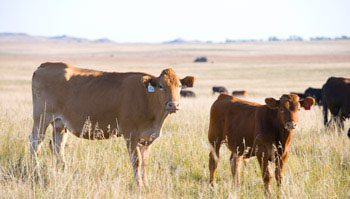
Photo: NRCS
Drought Management: Alternative Cattle Feed from Colorado State University
- Make use of local feeds as much as possible.
- Analyze forage and feed nutritive value and correctly supplement various quality feeds.
- Carefully balance every animal class’ feed requirements with the available feed rations.
- Move the herd into drylot and use a limit-fed, high grain diet. Grain or other concentrate feed can be substituted for hay (e.g., one pound of grain for two pounds of alfalfa hay or three pounds of grass hay). Cattle may behave as though hungry and appear to have difficulty adjusting at first, but they should adapt.
- (LeValley & McPhail, 2014)
Drought Management: Hay Production from Oklahoma State University
- Different hay production strategies and the impacts to winter feeding programs must be considered during a drought.
- It may be advisable to cut native hay fields only once per year. Later cuttings or double cuttings can reduce desirable forage species, as well as encourage weed infestation.
- In more intensively managed, introduced forage fields, producers may choose different strategies. One option is to focus on producing hay that is high in nutritive value by cutting multiple times. The alternative option is to focus on total dry matter production and ignore nutritive value by allowing forage to accumulate for fewer, but larger harvests.
- Varying quality hays will need to be appropriately matched to the animal requirement (e.g., growing vs. maintenance).
- (Bidwell & Redfearn, 2020)

Photo: NRCS
Table 2. Catlle Water Consumption Estimates (New Mexico State University, 2020).
Drought Management: Forage Management & Plant Toxicity from New Mexico State University
- Complete rest of pastures for at least one entire growing season is generally recommended following a severe drought to allow for forage recovery.
- Restocking to pre-drought numbers too quickly should be avoided. It may take as much as two years of rest if the pasture was grazed even moderately prior to the drought.
- Drought may force animals to consume poisonous plants they would normally avoid. Access to pastures with toxic plants may need to be restricted and plants removed.
- During periods of drought-induced dormancy of grasses, take note of healthy/green plants (e.g., weeds) and assess their toxicity potential. Nitrates and other toxic compounds in plants can rise with drought stress.
- (Ashcroft, 2016; New Mexico State University, 2020)
Drought Management: Nontraditional Forages from Kansas State Research and Extension
- Always test nontraditional forages for nitrate levels. High nitrate in plants is toxic. If toxic forage is not restricted in the diet (e.g., dilution), high mortality may occur.
- Options for obtaining good quality forage from nontraditional sources include: Austrian winter pea, spring pea, lentil, cowpea, soybean, canola, kale, rape, turnip, radish, and crabgrass. However, some of these crops have potential toxicity (or other antiquality) concerns that should be considered.
- (Rozeboom et al., 2008)
Drought Management: Cattle Water Quantity and Quality from Texas A&M
- Cattle need ready access to plentiful, clean water. For example, a 1,000 lb. heifer may require about 20 gallons of drinking water per day during hot weather.
- Cattle may need assistance in finding or accessing good water, especially when they are introduced to new pastures. Special care should be used to ensure weaned calves know where to find water.
- Water supplies should be monitored carefully to ensure the water is readily available, and to ensure needed maintenance on pumps, waterers, etc., is provided in a timely manner.
- As water sources dwindle during a drought, water quality may decline due to increased concentrations of salts and other inorganic materials. Water should be tested for concentrations of sodium, calcium, nitrate, magnesium salts, and sulfate, as well as potentially toxic metals or algae. If concentrations are high, fresh water from alternative sources must be provided.
- (Pfeifer, 2020)
Drought Management: Old World Bluestem Grasses, Annual Forages, & Interseeded Alfalfa from Texas Tech University
- Old world bluestem perennial grasses are adapted to semiarid and low-irrigation conditions of west Texas and eastern New Mexico for cow-calf and stocker production. A drought-preparing strategy is to establish them under limited irrigation with good weed control for a year and begin grazing in the second year. A well-adapted alfalfa variety can be interseeded at low density into the stand in early fall and grazed in the following late spring and summer. On a good soil, alfalfa can persist under drought if given a rest and allowed recovery from close grazing (Allen & Brown, 2010).
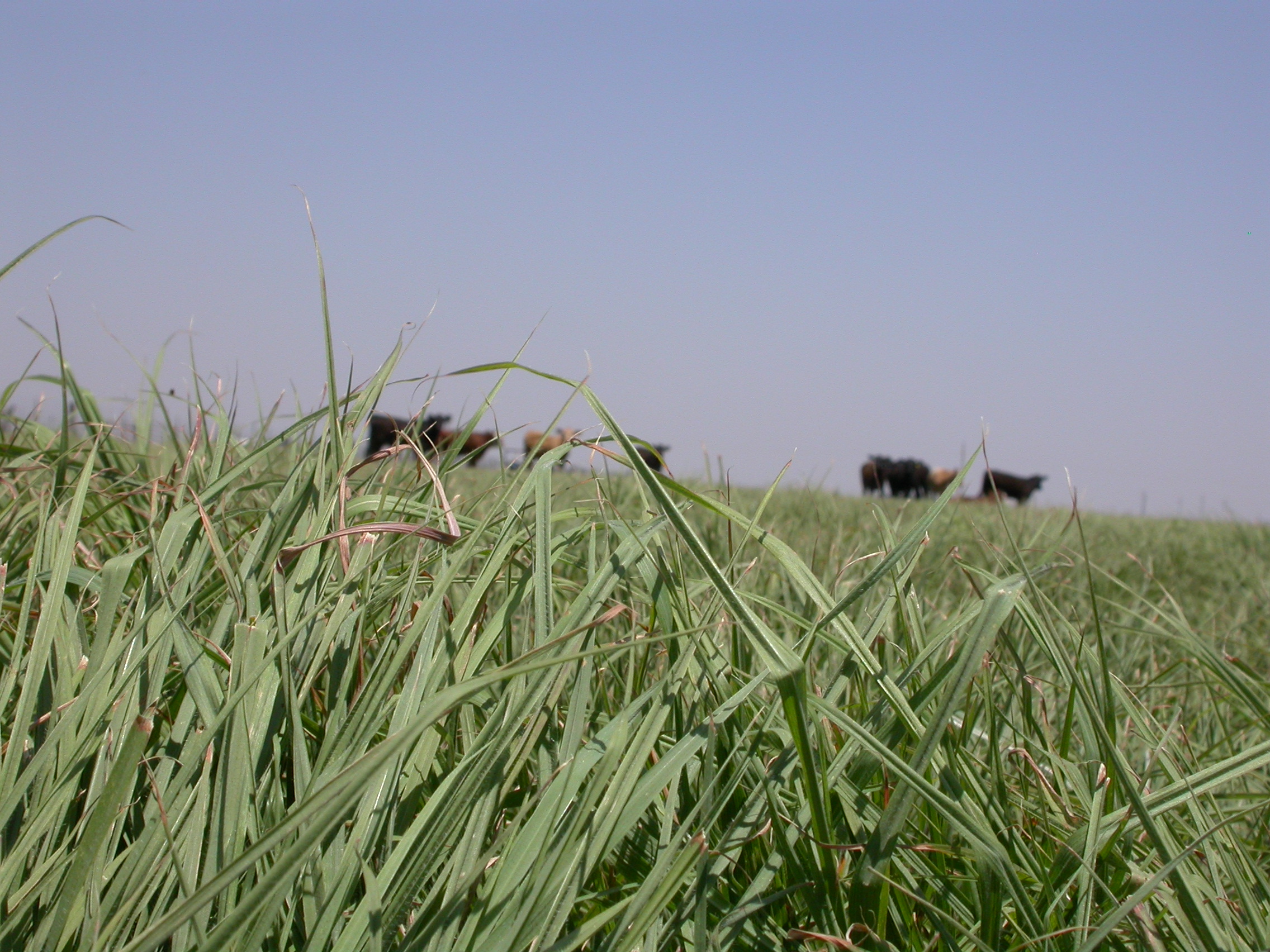
Old World bluestem variety “WW-B. Dahl” is one of the most promising introduced warm-season perennial grasses in the Texas High Plains. It has excellent longevity and potential for grazing, hay, seed production, and drought tolerance under dryland conditions, and it has exhibited excellent yields and weight gains for cattle under irrigation. Photo: Philip Brown
- Brown-midrib type sorghum-sudangrass hybrids and pearl millet are excellent summer annual grasses for grazing. Pearl millet is often preferred because of its lack of prussic acid risk under drought conditions, but both need to be monitored for toxic nitrate levels (West, Brown, Kellison, & Powers, 2020).
- Interseeding alfalfa at much lower density than normal, at 5.5 to 7 lbs./acre of live seed in wide rows, can be considered a viable means to improve native grass pastures in the southern High Plains to take advantage of the large increase in forage growth and nutritive value that alfalfa provides (Dhakal et al., 2020).
Drought Management: Alfalfa from New Mexico State University
- Alfalfa can go dormant during dry periods. The management goal during drought is to preserve the health of the alfalfa stand so it can recover once adequate precipitation or irrigation becomes available.
- Ensure that the soil moisture profile is full at the beginning of the season to allow alfalfa to utilize deeper moisture during mid-season heat and drought stress.
- If irrigation will be limited over the entire growing season, concentrate water applications on early cuttings during the spring when alfalfa uses water more efficiently.
- Apply water between cuttings after the canopy has closed (if possible) to minimize surface evaporation and germination of weeds that compete with alfalfa plants.
- Irrigation water should be tested regularly for changes in quality. The water requirement of the alfalfa crop may increase if water salinity increases. Alfalfa yields may be reduced when low quality water is applied.
- (Lauriault et al., 2009)
USDA Drought Programs and Assistance
Many USDA drought preparedness, response, and recovery programs are available for livestock and/or forage producers through USDA agencies:
- Natural Resources Conservation Service (NRCS),
- Farm Service Agency (FSA)
- Agricultural Research Service (ARS)
- United States Forest Service (USFS)
- Rural Development (RD)
- Risk Management Agency (RMA)
- Animal and Plant Health Inspection Service (APHIS)
NRCS, FSA, and RD are often co-located in county-level offices throughout the country — known as USDA Service Centers. Livestock and forage producers can visit their nearest USDA Service Center to learn about helpful drought programs and assistance.
Some key programs from USDA FSA that may provide drought assistance include:
- Noninsured Crop Disaster Assistance Program (NAP)
- Livestock Indemnity Program (LIP)
- Livestock Forage Program (LFP)
- Tree Assistance Program (TAP)
- Emergency Livestock Assistance Program (ELAP)
- Emergency Farm Loans
- Emergency Conservation Program
- Emergency Haying and Grazing of Conservation Reserve Program
Some relevant drought-preparedness, recovery, and conservation programs from USDA NRCS include:
Planning, Forecasting, & Monitoring Tools from National Drought Mitigation Center, University of Nebraska-Lincoln
- Managing Drought Risk on the Ranch: This guide helps Great Plains rangeland managers better prepare for and manage drought.
- Grassland Production Forecast: “Grass-cast” is a forecasting tool that can help form a more educated guess about grassland productivity for the upcoming growing season.
- Vegetation Drought Response Index: “VegDRI” is a weekly depiction of vegetation stress across the contiguous U.S.
- U.S. Drought Monitor: This weekly released map shows parts of the U.S. that are in drought.
“Drought is a normal part of climate…it will happen again. Fortunately, there are things you can do before, during, and after drought to reduce your risk.”
National Drought Mitigation Center
University Extension Drought Websites
University Extension Drought Webinars
- Texas A&M: “Rangeland Considerations During Dry Times (2020)”
- Texas A&M: “Pasture Management During and After a Drought (2020)”
- Texas A&M: “Lessons Learned in Preparing for Drought Management (2018)”
- University of Nebraska-Lincoln: Managing Grazing and Forages in the Midst of Dought (2013)
- University of Nebraska-Lincoln: “Drought Management Strategies: Destocking and Relocating Cow and/or Calves (2013)”
- Colorado State University: “Drought Webinar Series (2013)”
- Kansas State University: “Drought Options for Watering Livestock (2015)”
- Kansas State University: “Drought Concerns for Cattle Producers - Water Quality (2015)”
- Kansas State University: “Managerial Tools and Tips (2020)”
- Kansas State University: “Drought Preparedness for Cow/Calf Producers (2020)”
- Oklahoma State University: “Weather-Related Tax Implications (2018)”
References
Dhakal, M., West, C., Villalobos, C., Brown, P., Green, P., Kellison, R., Radicke, K., Sarturi, J., McCallister., D. (2020). Improving grassland with alfalfa in the Texas High Plains. Texas Tech University.
New Mexico State University Extension. (2020-a). Considerations for water during drought.
USDA National Agricultural Statistics Service (2012). Quick Stats.

